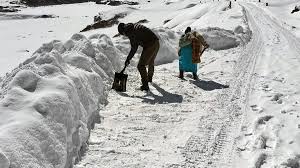Rapid Glacial Retreat in Arunachal Pradesh

- 05 Feb 2025
In News:
A recent scientific study has revealed that the eastern Himalayas in Arunachal Pradesh have lost 110 glaciers between 1988 and 2020, highlighting a critical impact of climate change in the region.
Key Findings of the Study
- Glacier Loss: The number of glaciers declined from 756 to 646 over 32 years.
- Glacial Area Reduction: Total glacial cover reduced from 585.23 sq. km to 309.85 sq. km, indicating a loss of over 47%.
- Retreat Rate: Glaciers retreated at a rate of 16.94 sq. km per year.
- Elevation: Most glaciers were located at 4,500–4,800 metres above mean sea level on north-facing slopes of 15°–35°.
- Remote Sensing & GIS: The study used advanced tools along with the Randolph Glacier Inventory to track and analyze glacier boundaries.
- Glacial Lakes: Retreat has led to the formation of numerous glacial lakes, increasing the risk of Glacial Lake Outburst Floods (GLOFs), as seen during the 2023 Sikkim disaster which killed at least 55 people and damaged a 1,200 MW Teesta hydropower project.
Causes of Glacial Retreat
- Climate Change:
- The eastern Himalayas are warming faster than the global average.
- Temperature rise: Between 0.1°C and 0.8°C per decade.
- Over the last century, the region has experienced an increase of ~1.6°C.
- By 2100, projections indicate a 5–6°C temperature rise and 20–30% increase in precipitation.
- Black Carbon Deposition: Emissions from human activities (e.g., vehicles, biomass burning) deposit soot on ice, reducing reflectivity (albedo) and increasing heat absorption.
- Erratic Snowfall Patterns: Changes in precipitation reduce snow accumulation, weakening glacier sustenance.
- Geological Factors: Local topography, altitude, and rock composition also influence glacier stability and response to warming.
Implications of Glacial Retreat
- Water Security
- The Himalayas are known as the ‘Third Pole’, storing the largest volume of ice outside the polar regions.
- They are vital for sustaining over 1.3 billion people in South Asia by feeding major rivers (Indus, Ganga, Brahmaputra).
- Glacial retreat threatens long-term freshwater availability, agriculture, and urban water supplies.
- Hydropower and Infrastructure
- Changing river flow patterns due to glacial melt affect hydropower generation and irrigation systems.
- Risk of infrastructure damage from GLOFs is rising.
- Biodiversity and Agriculture: Altered ecosystems and climatic stress impact Himalayan biodiversity and disrupt traditional farming practices.
Himalayan Glaciers and River Systems
- Indus Basin: Originates from Lake Mansarovar; flows through Ladakh and Pakistan.
- Ganga Basin: Emerges from Gangotri Glacier in Uttarakhand; forms the Ganga after merging with Alaknanda.
- Brahmaputra Basin: Rises near Kailash range in Tibet; flows through Arunachal Pradesh, Assam, and Bangladesh.
Major Glaciers in India
Glacier Region Importance
Siachen Ladakh Longest glacier in India (76 km)
Gangotri Uttarakhand Source of the Ganga
Yamunotri Uttarakhand Origin of the Yamuna
Zemu Sikkim Largest glacier in Eastern Himalayas
Rathong Sikkim Feeds Teesta River
Milam Uttarakhand Source of Goriganga River
Pindari Uttarakhand Glacial trekking route
Glacial Lake Outburst Floods (GLOFs)
- GLOFs are sudden discharges of water from glacial lakes, often caused by moraine dam failures.
- These can trigger catastrophic downstream floods, threatening lives, infrastructure, and ecosystems.
Mitigation and Adaptation Strategies
- Climate Action: Drastic cuts in greenhouse gas emissions at national and global levels.
- Sustainable Water Management: Enhance glacier-fed river basin planning.
- Disaster Risk Reduction: GLOF early-warning systems, resilient infrastructure, and relocation policies.
- Community Participation: Local awareness, traditional knowledge integration, and eco-restoration efforts.
- International Cooperation: Transboundary initiatives under frameworks like the HKH (Hindu Kush Himalaya) Monitoring Network and UNFCCC.
